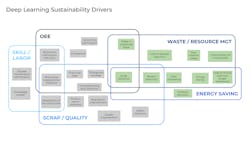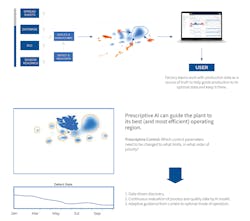Using Deep Learning as Prescriptive Analytics for Energy Optimization
Deep learning applied as prescriptive analytics harnesses computing power to learn and make predictions or decisions based on data. This is particularly salient in manufacturing as AI-driven solutions can embed product and quality traceability in software to optimize production processes preemptively and holistically. For manufacturing professionals, this can mean stepping out from a reactive, ‘firefighting’ paradigm into a workflow that is digitally proactive, innovative, and sustainable.
More specifically, state-of-the-art AI can be used to help manufacturers identify patterns and trends hidden within large volumes of historical and current energy consumption data and prescribe adjustments ahead of real time—leading to continuous improvements in energy efficiency and cost savings, and an overall lower environmental impact.
AI for Reduced Energy Consumption
Efficiencies gained through AI-driven process optimization naturally result in reduced energy consumption across the production line. While energy savings may be considered a side-effect, they are often a target on their own. In each of these cases, AI-driven process optimization is a powerful tool.
When applied specifically to reduce energy consumption, AI-driven process optimization solutions are able to identify various hidden power drains in the control plan.
Why should this matter? According to the U.S Energy Information Administration, manufacturing accounted for the largest share of annual industrial energy consumption in 2021.
Some of the most common energy sources being used are:
- Natural gas
- Electricity
- Petroleum
- Renewable sources
- Coal
AI-driven solutions help to identify inefficiencies relating to the energy sources above that may not be realized through traditional means alone.
With deep learning insights, production parameter interdependencies can be revealed that will take the plant to its most optimal state, while ensuring the lowest energy usage.
How Deep Learning Applied as Prescriptive Analytics Leverages Plant Data
Now that we understand that deep learning applied as prescriptive analytics is a powerful tool for process optimization and energy consumption reduction, it's important to understand how it achieves more sustainable production.
It all starts with data.
Data is the fuel that feeds process optimization and energy savings initiatives. AI-ready IIoT platforms capture raw feeds from multiple sources to gain a unified view of the production process. Sources include traditional databases, spreadsheets, streaming sensors, and PLC information.
Through deep learning algorithms, the Expert Execution System (EES) uses historical, process, and quality data to recognize the plant's dynamic state and determine whether the production process is within ideal operating ranges. The system then acts ahead of real time to prescribe small process parameter changes to the operators, process engineers, and technicians.
It’s important to note that the data gathered in this cyber-physical environment is not always contextualized, current, and complete. But it needs to be. For AI to solve optimization problems, missing, redundant or stagnant data will not reflect an actual production state and is of little use. AI-ready IIoT stacks are required to render optimization critical data ready for AI modeling and prescription generation.
By implementing these incremental prescriptions, plant personnel are able to proactively optimize control plans towards the plant’s best-of-best (BOB) region. This way, continued energy efficiency is ensured throughout the production process, resulting in cost savings, emissions reduction, reduced overprocessing, and cycle time—or a combination thereof.
Why AI for Sustainably Prescriptive Line Control?
State-of-the-art AI’s suitability for optimal energy consumption pertains to it being holistic and manufacturing process agnostic.
The idea that AI-driven solutions are holistic suggests that the prescriptive corrections capture the behavioral impact relevant to production process variables in their entirety. In other words, the interdependent variables circumscribing the relevant production outcomes are accounted for in the modeling in consultation with in-house functional manufacturing experts—to solicit the continual optimization of global plant performance.
AI for dynamic, prescriptive line control is also described as being manufacturing process agnostic. This suggests that AI models have the capability of optimizing various processes provided there is sufficient AI-ready data available. For this reason, AI-driven process optimization can be leveraged across an array of verticals, including automotive, rubber, semiconductor, metalworking, welding, mineral processing, and gray iron foundries.
Deep Learning Prescriptive Analytics Industry Use Cases
There are many cases where the use of AI in production processes has proved to be successful—particularly for manufacturing energy optimization.
Recently, one of the largest foundries and largest manufacturers of iron engine blocks and cylinder heads leveraged deep learning prescriptive analytics to optimize its manufacturing process to reduce scrap and shipped defects. With this solution, the foundry achieved its goal—realizing an external scrap rate of less than 0.1%—and experienced a significant reduction in waste, energy, and carbon emissions consumption (297 pounds (135 kilograms) of carbon dioxide emissions for each defective block not shipped), as well as increased yields and revenue (saving $100,000 per month).
One of the world’s leading manufacturers of light-alloy wheels for premium vehicles also realized similar gains through the implementation of AI. The global automotive OEM deployed an AI-driven process optimization solution to reduce ‘hot’ and X-ray scrap produced during its manufacturing process. Adjustments to the control plan made based on AI prescriptions led to a 29% reduction in scrap, a 2.4% increase in production volume, and $500,000 in gross annual savings. Improved efficiencies also resulted in the reduction of energy consumption across the OEMs production line.
These examples show how holistic process optimization indirectly bootstraps energy optimization. Note, however, that optimized energy usage is also an example of a direct KPI that could just as easily be targeted in any of the above AI use cases.
For instance, if a production process is expending an unfavorable amount of energy to maintain a certain level of scrap, deep learning can be harnessed to home in on parametric interactions which sustain (and even improve) the desired scrap rate while using less power.
Start Achieving Energy Optimization Through AI
To conclude, by microtargeting specific sustainability KPIs, manufacturers (including utility engineers, sustainability managers, and continuous improvement managers) can take control of their most relevant performance metrics. Reducing shipped defects, lessening rework, increasing throughput, improving overall equipment effectiveness (OEE), slashing waste, and optimizing energy efficiency are all within their sights with the right AI technology partner.
Additionally, AI models are capable of adapting to changing conditions, making AI-driven solutions a valuable tool for solving the dynamic and complex challenges of energy optimization in manufacturing as plants evolve.
The big picture here is that this toolset significantly increases cost savings and improves manufacturers’ overall sustainability and competitiveness in their respective industries, future-proofing their operations for the digital age.
Nicol Ritchie is a writer with extensive corporate experience in technical long-form writing across a range of industries including financial services, digital advisories, and corporate social responsibility. Nicol holds a master’s degree in Applied Linguistics.



